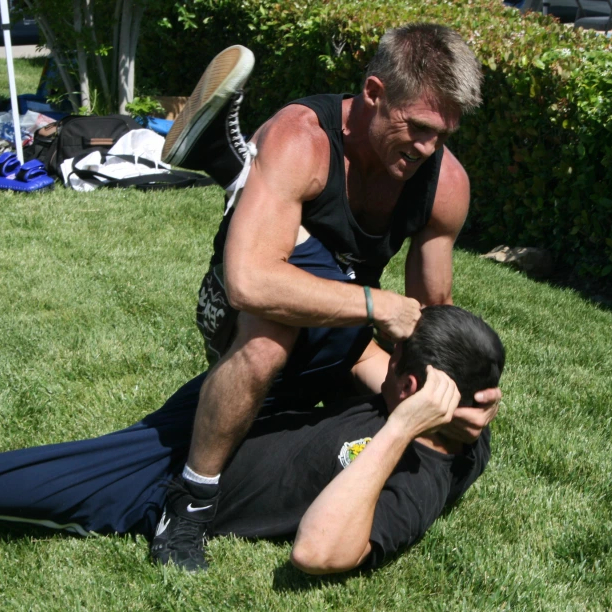Become a Great Grappler
Contents
Becoming a great grappler is not an easy thing to do. If you want to be a great grappler you must work very hard and make many sacrifices.
The Mental Aspect of Grappling Excellence
Becoming a great grappler is not an easy thing to do. If you want to be a great grappler you must work very hard and make many sacrifices. Most people have no idea of what hard work is—ask anyone born before electricity or hot and cold running water and they can tell you what hard work is.
To become a great grappler you have to have the mental toughness to overcome many things like being frustrated and disappointed with yourself. You must force yourself to workout when you least feel like doing it (that is when you need it the most) without over training. If you can get through the mental war half of the fight is won. The rest is just the training.
The key to become a great grappler is the ability to keep training over a long period of time regardless of what fads come and go. Do your training consistently and correctly. Remember! Perfect practice makes perfect.
You will need dedication, determination and physical and mental toughness as well. You must be willing to train like a machine and like you have never trained before.
Learning From Legends: Gene LeBell

One of the greatest grapplers ever, my friend, Judo Gene LeBell, at age 73 is still one of the best technicians in the world. Gene has taught many of the great grapplers of today, including Gokor, Karo Parizyan and Erik Paulson. The list goes on. Not too many people know this story but the Shamrock brothers had an apartment near Gene’s school about 15 years ago for about 6 months but they never mentioned him in the Lion’s Den book. (Go figure). Gene had more than 2,000 judo matches in his life he won every one but one and he later avenged that loss. When he hip threw the guy he landed on the guy’s leg and broke it.
Gene LeBell’s Incredible Work Ethic
When Gene was competing he had the sickest work out routine. He would train 6 hours a day.
His regimen included:
- 1,000 push ups every other day
- 1,000 sit ups every other day
- Climbing up and down ropes (with one rope in each hand)
- Running hills with a 20 pound log on his back
- Throwing car tires and sprinting to retrieve them (for 45-60 minutes)
This developed his:
- Waist muscles
- Leg strength
- Lung capacity
- Back muscles
Gene believes that 60% is physical conditioning and 40% is technique. No matter how skillful a fighter is if he gets tired during a fight he becomes a less skillful fighter. I always say, a musician will never go on stage without his or her instrument tuned and same should apply to fighters and grapplers. A lot of fighters will go on stage without their instrument tuned and you can see it in their performance.
Following The Footsteps of Great Grapplers
To become a great grappler we can follow the examples of the great grapplers that came before us:
-
Farmer Burns could jump off a 6 foot table with a hangman noose around his neck and his hands tied behind his back and whistle Yankee doodle dandy. That was how strong his neck was.
-
Karl Gotch brought catch wrestling to Japan.
-
Dan Gable won the gold medal in the Olympics.
-
Gene LaBell - well, you know about him.
A great grappler will always spend more time grappling and working on his grappling skills than trying to become a body builder or Mr. Olympia. What great grapplers strive for are muscles that are functional for grappling and or fighting.
Training for Functional Strength
The best way to develop your grappling abilities is to focus on exercises that directly enhance your performance on the mat:
- Grip strength training: Using grippers, towel pull-ups, and gi grip exercises
- Core development: Planks, Russian twists, and medicine ball exercises
- Explosive movements: Box jumps, kettlebell swings, and medicine ball throws
- Isometric strength: Wall sits, bridge positions, and static holds
Remember that as a grappler, your goal is not to look impressive but to perform impressively. Focus on training that translates directly to better performance in your sport.
About the Author

Lester Griffin
Lester Griffin is a professional martial artist and certified instructor with over 30 years of experience. He currently teaches Jeet Kune Do, Grappling, Muay Thai, Savate, and Kali at Griffin Martial Arts in San Jacinto, CA. He also regularly judges UFC and King of the Cage events.
You Might Also Enjoy
Lester's Logic 4 – Muay Thai Scoop and Return
You scoop your opponent's teep kick and return a round kick to the leg. Work this until it becomes second nature.
Lester's Logic 3 – Muay Thai Clinch Counter
This is a move you can use against a typical Greco attempt to tie up an arm, go straight to the Muay Thai Plum and go for the skip knees, then throw them into oncoming traffic!
